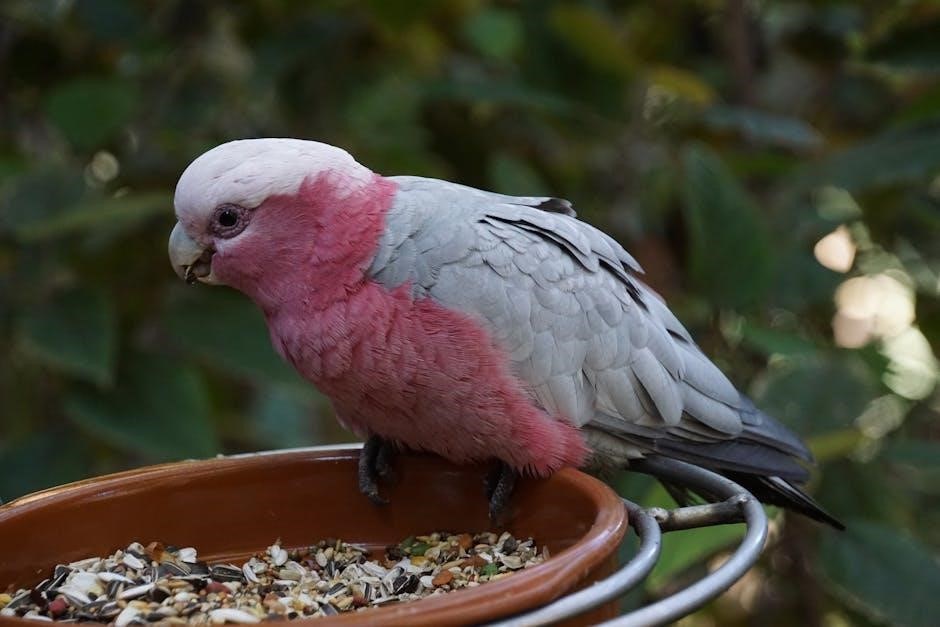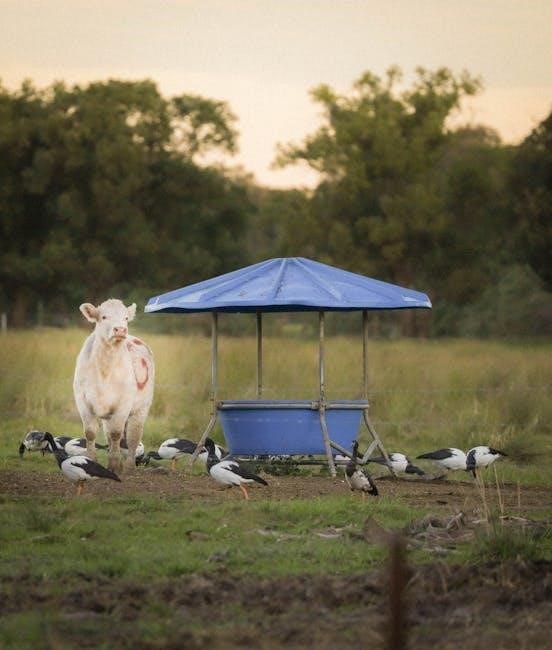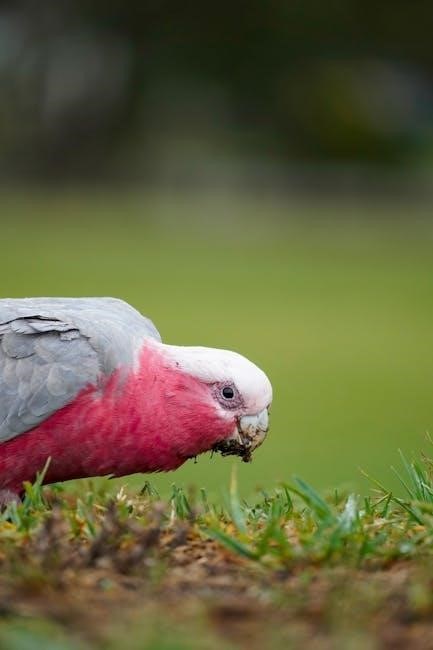
weed and feed instructions australia

Maintaining a healthy and weed-free lawn in Australia requires careful planning and execution․ Understanding the proper application techniques for weed and feed products is essential for achieving optimal results․ These instructions provide a comprehensive guide for Australian homeowners․

Weed and feed products are a convenient solution for Australian homeowners seeking to simultaneously fertilize their lawns and control unwanted weeds․ These products typically combine a fertilizer, which provides essential nutrients for healthy grass growth, with a herbicide, which targets and eliminates common lawn weeds such as clover, dandelions, and thistles․ The Australian market offers a variety of weed and feed formulations, catering to different grass types and weed pressures․
Understanding the specific needs of your lawn is crucial before applying any weed and feed product․ Factors such as grass type, soil condition, and the prevalence of specific weed species should be considered․ Selecting the appropriate product and following the application instructions carefully will ensure that your lawn receives the necessary nutrients while effectively controlling weeds․
This guide provides detailed instructions on the proper use of weed and feed products in Australia, covering optimal timing, application methods, dosage, and post-application care․ By following these guidelines, you can achieve a lush, healthy, and weed-free lawn that enhances the beauty of your property․
Optimal Timing for Application in Australia
Achieving the best results with weed and feed products in Australia hinges on applying them at the right time of year․ The ideal timing coincides with periods of active grass growth and weed emergence, typically during early spring and autumn․ These seasons provide the most favorable conditions for both the fertilizer to nourish the lawn and the herbicide to effectively control weeds․

In early spring, as temperatures begin to rise and lawns emerge from winter dormancy, weeds start to actively grow․ Applying weed and feed at this time allows the herbicide to target young, vulnerable weeds, preventing them from establishing and spreading․ Additionally, the fertilizer component supports the lawn’s recovery and promotes vigorous growth․
Autumn presents another opportunity for weed and feed application․ As temperatures cool down, weeds that germinated during the summer months become more susceptible to herbicides․ Applying weed and feed in autumn also helps to strengthen the lawn’s root system before winter, making it more resilient to cold weather and weed competition in the following spring․
Spring Application Guidelines
Applying weed and feed in spring requires careful consideration of several factors to maximize effectiveness․ Timing is crucial; aim for early spring when the lawn is actively growing but before weeds become too established․ Ensure the grass is moist before application, either through recent rainfall or irrigation, as this helps the granules adhere to weed leaves․
Choose a day with calm weather to prevent the product from drifting onto unintended areas․ Avoid application if heavy rain is expected within 24-48 hours, as it can wash away the weed and feed before it has time to work․
Use a spreader to ensure even distribution of the product across the lawn, following the manufacturer’s recommended application rate․ Over-application can damage the grass, while under-application may not effectively control weeds․
After application, water the lawn lightly to help the fertilizer dissolve and the herbicide activate․ Keep pets and children off the treated area for the period specified on the product label to ensure their safety․
Autumn Application Guidelines
Autumn provides another ideal window for applying weed and feed in Australia, preparing your lawn for the winter months and setting it up for strong growth in the spring․ Similar to spring applications, timing is key; aim for mid-autumn when the soil is still warm enough for the grass to actively grow, but before the first frost․

Before applying, remove any fallen leaves and debris from the lawn to ensure the weed and feed can reach the soil and weeds effectively․ As with spring applications, make sure the grass is moist before applying the product to help it adhere to weed leaves․

Use a spreader to evenly distribute the weed and feed, carefully following the manufacturer’s instructions regarding application rate․ Avoid applying if rain is expected within 24 hours to prevent runoff․

After application, water the lawn lightly to help the fertilizer dissolve and the herbicide activate․ Keep pets and children off the lawn until it has dried completely․ Autumn applications help control winter weeds and provide essential nutrients for the grass to store over winter․
Temperature Considerations for Application
Temperature plays a crucial role in the effectiveness of weed and feed applications․ Applying these products under suboptimal temperature conditions can lead to poor weed control and potential damage to your lawn․ Understanding the ideal temperature range is essential for maximizing the benefits of weed and feed․
Generally, weed and feed products work best when the daytime temperatures are consistently between 15․5°C and 32°C (60°F and 90°F)․ This range ensures that both the grass and the weeds are actively growing, allowing them to absorb the fertilizer and herbicide effectively․ Applying weed and feed when temperatures are too low can reduce the product’s efficacy, as the weeds may not be actively growing and absorbing the herbicide․
Conversely, applying weed and feed when temperatures are too high can stress the grass and potentially cause damage․ High temperatures can also lead to rapid evaporation of liquid products, reducing their effectiveness․ Always check the product label for specific temperature recommendations, as these may vary depending on the formulation․
Ideal Temperature Range (15․5-32°C)
The sweet spot for weed and feed application lies within a temperature range of 15․5 to 32 degrees Celsius (60 to 90 degrees Fahrenheit)․ Within this range, both your lawn and the targeted weeds are actively growing, facilitating optimal absorption of the product’s nutrients and herbicides․ This active growth ensures that the fertilizer component is readily taken up by the grass, promoting lush, green growth․ Simultaneously, the herbicide is effectively absorbed by the weeds, leading to their control and eventual elimination․
Applying weed and feed outside this ideal temperature range can significantly reduce its effectiveness․ Cooler temperatures can slow down plant metabolism, hindering both nutrient uptake and herbicide absorption․ Warmer temperatures, on the other hand, can stress the lawn and potentially damage it, while also causing the herbicide to volatilize or degrade rapidly․ Therefore, monitoring the weather forecast and planning your application during periods when temperatures are consistently within the recommended range is crucial for achieving the best possible results․
Application Methods: Granular vs․ Liquid
When it comes to applying weed and feed, two primary methods stand out: granular and liquid application․ Each method has its own set of advantages and disadvantages, making it crucial to choose the one that best suits your lawn care needs and preferences․ Granular weed and feed products typically consist of small pellets that are spread evenly across the lawn using a spreader․ This method offers the advantage of slow-release fertilization, providing a sustained supply of nutrients over an extended period․ Granular applications are generally less prone to drift, making them a good choice for windy conditions․
Liquid weed and feed, on the other hand, is applied as a spray using a hose-end sprayer or a tank sprayer․ This method allows for more precise application, ensuring that the product reaches even hard-to-reach areas; Liquid applications also tend to be faster-acting, delivering nutrients and herbicides directly to the plant foliage and roots․ However, liquid applications are more susceptible to drift and may require more careful attention to weather conditions․

Granular Application Instructions
Achieving an even and effective distribution of granular weed and feed requires careful attention to detail․ Before beginning, ensure your lawn is slightly moist, which helps the granules adhere to the soil and plant surfaces․ Use a calibrated spreader, either a broadcast or drop spreader, to apply the product․ Calibrating ensures that the correct amount of weed and feed is distributed across your lawn, preventing over- or under-application․

For broadcast spreaders, overlap each pass slightly to ensure complete coverage․ With drop spreaders, carefully align each pass to avoid gaps or excessive overlap․ Apply the granular product evenly across the entire lawn, paying close attention to edges and corners where weeds often thrive․ After application, lightly water the lawn to help the granules dissolve and release their active ingredients․ Avoid heavy watering, which can wash away the product before it has a chance to work․ Monitor your lawn over the next few weeks and reapply as needed, following the manufacturer’s instructions․
Liquid Application Instructions
Applying liquid weed and feed requires a different approach compared to granular products, but it can be equally effective when done correctly․ First, ensure your lawn is actively growing and free from excessive thatch․ Use a hose-end sprayer or a tank sprayer to apply the liquid solution․ If using a hose-end sprayer, follow the manufacturer’s instructions to properly dilute the concentrate with water․ For tank sprayers, mix the solution according to the label directions, ensuring thorough mixing before application․
Begin spraying the lawn in a systematic manner, overlapping each pass slightly to ensure uniform coverage․ Maintain a consistent walking speed and spray pattern to avoid over- or under-application․ Pay close attention to areas with heavy weed infestation, but avoid saturating the lawn, as this can lead to runoff and reduced effectiveness․ After application, allow the solution to dry on the lawn for several hours before watering․ This allows the active ingredients to be absorbed by the weeds and the grass․ Monitor the lawn for weed control and grass greening over the next few weeks, and reapply if necessary, following the product label recommendations․
Dosage and Coverage
Achieving the desired results with weed and feed products heavily relies on applying the correct dosage and ensuring adequate coverage across your lawn․ Over-application can harm your grass, while under-application may not effectively control weeds or provide sufficient nutrients․ Always consult the product label for specific dosage recommendations tailored to your lawn size and the type of weeds you’re targeting․
Measure your lawn area accurately before application․ This will help you determine the precise amount of product needed․ Use a calibrated spreader or sprayer to ensure even distribution․ For granular products, calibrate your spreader according to the label instructions and walk at a consistent pace to avoid uneven application․ For liquid products, use a sprayer nozzle that delivers a consistent spray pattern and avoid overlapping excessively․ After application, observe your lawn for any signs of over- or under-application, such as yellowing grass or persistent weeds․ Adjust your application technique accordingly for future treatments․ Proper dosage and coverage are key to maximizing the effectiveness of weed and feed while minimizing potential risks to your lawn․
Recommended Application Rate (e․g․, 2․5kg/100m²)
The recommended application rate for weed and feed products in Australia is crucial for achieving optimal results without harming your lawn․ A common guideline suggests applying approximately 2․5kg of granular weed and feed per 100 square meters of lawn area․ However, this rate can vary depending on the specific product formulation, the type of grass you have, and the severity of weed infestation․
Always refer to the product label for the manufacturer’s recommended application rate․ This information is typically expressed in kilograms per square meter or pounds per square foot․ Use a measuring tool to accurately determine the amount of product needed for your lawn size․ When applying granular products, calibrate your spreader to deliver the correct amount․ For liquid products, use a sprayer that dispenses the recommended volume per unit area․ Avoid exceeding the recommended application rate, as this can lead to fertilizer burn or damage to your grass․ If you are unsure about the correct application rate, it is always best to err on the side of caution and apply a slightly lower amount․ Monitor your lawn after application and adjust accordingly for future treatments․
Weed Control Effectiveness
The effectiveness of weed and feed products in controlling weeds depends on several factors, including the type of weeds present, the timing of application, and the specific formulation of the product․ Weed and feed products are designed to target broadleaf weeds while simultaneously providing nutrients to the lawn․ However, not all weed and feed products are effective against all types of weeds․

Some products are more effective against common weeds like clover, dandelions, and thistles, while others may target a broader range of weed species․ To maximize weed control effectiveness, it is essential to identify the types of weeds present in your lawn and choose a weed and feed product that is specifically formulated to target those weeds․ Additionally, applying weed and feed when weeds are actively growing, typically in the spring or autumn, will improve the product’s ability to penetrate and kill the weeds․ Regular applications, as directed by the product label, may be necessary to achieve long-term weed control․ It is also important to note that some weeds may require multiple applications or alternative control methods to be fully eradicated․
Target Weeds (Clover, Dandelions, Thistles)
Weed and feed products are specifically formulated to target common broadleaf weeds that can detract from the appearance and health of your lawn․ Among the most prevalent target weeds are clover, dandelions, and thistles, each possessing unique characteristics that require effective control strategies․ Clover, often recognized by its three-leaf structure (and occasional lucky four-leaf variant), can quickly spread and dominate lawn areas, competing with desirable grasses for resources․ Dandelions, with their bright yellow flowers and distinctive seed heads, are equally persistent, readily dispersing seeds via wind to colonize new areas․
Thistles, characterized by their prickly leaves and stems, pose a more significant challenge due to their robust root systems and ability to regenerate from root fragments․ Effective weed and feed products contain herbicides specifically designed to disrupt the growth and development of these target weeds, leading to their eventual demise․ By carefully selecting a product that targets these specific weeds and following the recommended application instructions, homeowners can achieve a healthier, more visually appealing lawn free from the intrusion of clover, dandelions, and thistles․
Post-Application Care
Following the application of weed and feed, proper post-application care is crucial to maximize its effectiveness and ensure the long-term health of your lawn․ One of the most important steps is to avoid mowing the treated area for at least 24 to 48 hours, allowing the herbicides sufficient time to be absorbed by the target weeds․ Additionally, it is advisable to withhold watering or irrigation for a similar period, as excessive moisture can dilute the product and reduce its efficacy․
Monitor the treated area for signs of weed control, such as yellowing or wilting of the target weeds, which typically become visible within a week or two․ If necessary, a second application may be required for particularly stubborn weeds, but always adhere to the manufacturer’s recommendations regarding application intervals and dosage․ Furthermore, consider applying a lawn fertilizer a few weeks after the weed and feed treatment to provide essential nutrients that promote healthy grass growth and help the lawn recover from any stress caused by the herbicide application․ This holistic approach to lawn care will contribute to a vibrant, weed-free lawn․
Leave a Reply
You must be logged in to post a comment.